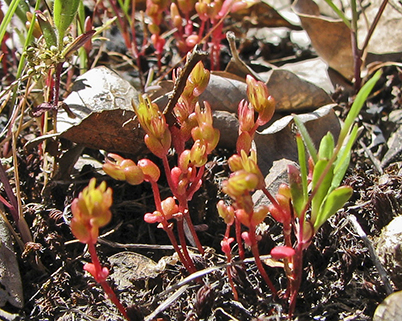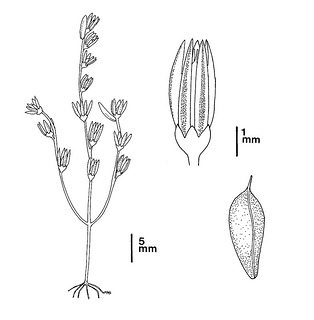Sedella leiocarpa
 Sedella leiocarpa. Photo by Cherilyn Burton ©
Sedella leiocarpa. Photo by Cherilyn Burton ©
 Sedella leiocarpa. CDFW illustration by Mary Ann Showers. (Click to enlarge)
Sedella leiocarpa. CDFW illustration by Mary Ann Showers. (Click to enlarge)
Lake County stonecrop is a California endangered plant species, which means that killing or possessing this plant is prohibited by the California Endangered Species Act (CESA). This species is also listed as endangered under the federal Endangered Species Act(opens in new tab). Lake County stonecrop is a low-growing, fleshy annual herb that typically flowers from April to May. It grows in seasonally wet depressions and shallow vernal pools, typically on gravelly volcanic substrates. Its reddish, hairless stems grow up to two inches tall. Lake County stonecrop is only known from Lake County, and the California Natural Diversity Database only identifies six extant occurrences of the species. The USFWS 5-year review of this species (PDF)(opens in new tab) (2009) reports that plants have not been observed at two of these occurrences since the 1940’s; one occurrence has been converted to vineyards and surveys in 2006 and 2007 did not locate this species; the status of one occurrence is unknown; and two occurrences were located in 2006 and 2007 surveys.
Primary threats to Lake County stonecrop include alteration of hydrology, effects from road maintenance and widening activities, land conversion for agriculture and housing, off-highway vehicle use, and trampling by cattle. Erosion could also pose a risk for the population at Manning Flat. Continued existence of this species is threatened by its restricted range, few populations, and highly specific habitat. In addition to these threats, climate change is also a concern.
Protection and preservation of Lake County stonecrop populations is imperative to recovery of this species. Known occurrences are located on private property, and no known conservation measures have been implemented by any of the landowners. In addition, research should be conducted at as many of the extant localities as possible. Research should include developing a standardized monitoring method to monitor population trends and species status at all known locations, and examining the genetic structure of the species to determine if it is affected by breeding system limitations such as inbreeding depression, low reproductive rate, or loss of genetic diversity. Research should also focus on examining if the species is insect-pollinated. Seeds should also be collected for long-term conservation storage and for future introduction and reintroductions into suitable habitat.
CDFW may issue permits for Lake County stonecrop pursuant to CESA, and you can learn more about the California laws protecting Lake County stonecrop and other California native plants. Populations of Lake County stonecrop occur in CDFW's North Central Region. More information is also available from the United States Fish and Wildlife Service Species Profile for Lake County stonecropUnited States Fish and Wildlife Service Species Profile for Lake County stonecrop(opens in new tab).
Updated 3/19/2013